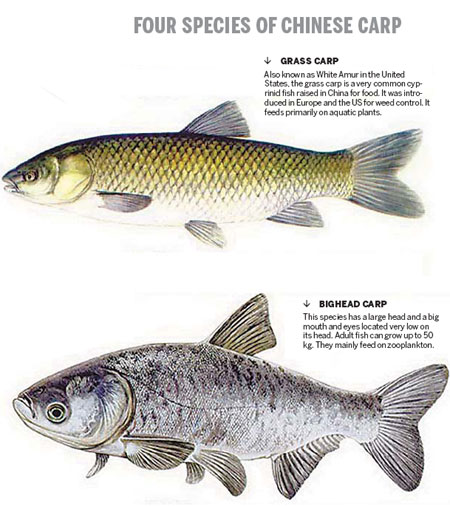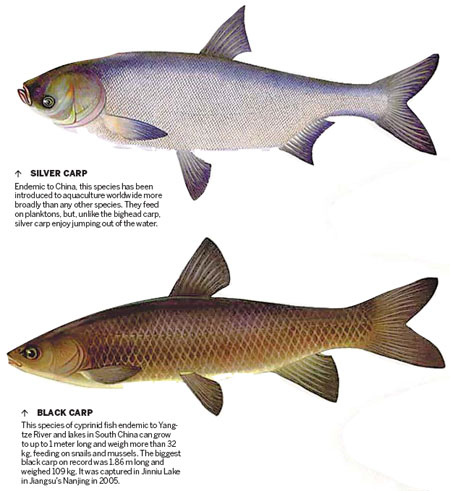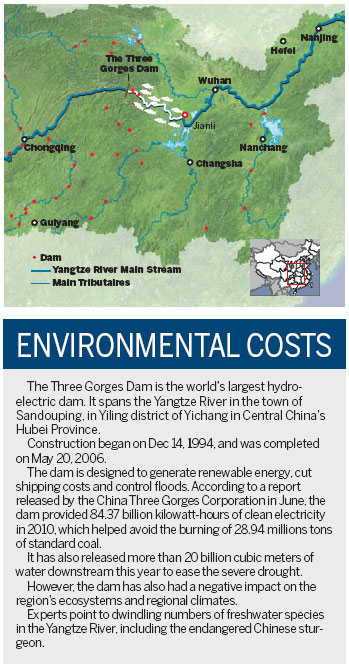Society
Battling against the current
Updated: 2011-07-07 08:07
By Wang Ru (China Daily)


Operators of the Three Gorges Dam have, for the first time, added to the flows downstream to help the spawning of Yangtze River carp. Wang Ru reports.
The Three Gorges Dam has regulated its water flow for the first time since being put into operation in August 2009 to allow for the spawning of Chinese carp. This marks a significant step toward minimizing the mammoth hydroelectric project's ecological impact on the central and lower reaches of the Yangtze River. Over six days from June 16, the dam added 2,000 cubic meters per second to its daily discharge downstream in an attempt to mimic natural floods, which is crucial for the carp's spawning. "It is a vital decision and a great opportunity to revive the endangered fish population in the Yangtze River," says Chen Daqing, deputy director of Yangtze River Fisheries Research Institute under the Chinese Academy of Fishery Sciences (CAFS). About 60 percent of China's freshwater fish come from the Yangtze River, with four species of Chinese carp (black, grass, bighead and silver carp) found mainly in this area.
But human activities, including over-fishing, shipping, pollution, wetland reclamation and waterway modification have decreased the fishery resources in the Yangtze River basin over the past 30 years.
"Chinese carp usually spawn in the Yangtze from the end of April until the beginning of July," Zhao Yimin, division chief of the Yangtze Fishery Resources Commission (YFC), says. "But the Three Gorges Dam reservoir operates at a low water level from April to May every year, which has changed the conditions in the spawning sites, with an adverse impact on the reproduction of the carp."
Guo Qiaoyu, manager for the Yangtze River project from the China office of The Nature Conservancy (TNC), a US-based international conservation organization, says: "The fishes in the Yangtze River spawn in fast-moving rivers, and their eggs, which are slightly heavier than fresh water, only develop while drifting downstream, suspended by the turbulence.
"Without the turbulence, the eggs could die if they sink to the bottom."
The carp also require other conditions, such as sustained water temperatures of between 18 C and 25 C, and specific water levels and flows. But ever since the Three Gorges Dam's first water impoundment in 2003, the flows needed for Chinese carp have not been met.
Since the 1960s, there has been a 90-percent reduction in carp spawning.
According to the CAFS fisheries institute, there has been an observable decline of Chinese carp in the central Yangtze River. According to data collected in Jianli county on this stretch, the annual average amount of fish fry has declined from 2.524 billion between 1997 and 2003 (before the water impoundment of the Three Gorges Dam) to 42 million in 2009.
A popular delicacy in Chinese cuisine, the carp population in the region is an important indicator of the health of the local ecosystem.
"The decline is an indication of the urgency to protect and replenish the Yangtze's most economically important fish," Chen Daqing says.
The Yangtze River twists and turns 157 kilometers in the area of Jianli, an important breeding ground for various fish including the Chinese carp. In 2010, the Ministry of Agriculture established the national fishery resource reserve in Jianli for the Yangtze River carp.
To help prevent any further decline of fishery resources, the Changjiang Water Resources Commission (CWRC), CTGPC, TNC and World Wildlife Fund (WWF) are working together to implement a number of ecological guidelines. These include reconnecting rivers and lakes; aiding carp breeding by releasing fish fry, adult fish and live-bearing fish into rivers and making sure they have sufficient and timely water resources; and improving the Three Gorges Dam's water flows.
On April 22, World Earth Day, more than 1,000 carp were released in Jianli, in Central China's Hubei province. The carp would only start to spawn upstream when the water levels rose.
Many Jianli residents watched the fish release. While they had lived on fishing for generations, there are now too few fish to make a living. Most residents are working in factories and at docks.
Mimicking natural floods so the fish spawn has been tried successfully in the United States. As part of the project, TNC invited five experts on fish ecology from the US to work with Chinese researchers.
"According to our experiences on the Mississippi River, 70 percent of eggs of carp in the Yangtze River will die without proper hydrological conditions," says James Garvey, professor of the department of zoology of Southern Illinois University.
Modern concrete dams have devastated fish populations worldwide. About 50 years ago, the construction of dams on Columbia River caused a rapid decline of the salmon population.
"Managers of the dams on Columbia River are collaborating with scientists to save the fish. During the spawning season, the dams discharge additional water day and night based on our research report. Fish passages and elevators are also built on the dams for the passing of fish," Steven Haeseker, an expert from the Columbia River Fishery Program Office, says.
"The discharge should consider other species like birds, which nest on shoals. The flood will, inevitably, also impact them. So it is a complex project which requires the full cooperation of the dams."
The attitude of the operator of the Three Gorges Dam, CTGPC, was crucial to the success of the project. It was at an April 14 meeting between TNC chief Mark Tercek and Cao Guangjing, chairman of the CTGPC, that the decision to go ahead with the water discharge in June was taken.
Scientists are monitoring the results of the project. The carp have been tracked by researchers from the CAFS fisheries institute, since the first release of the fish in April.
"The carp we released have reached their spawning site upstream. The water discharge from the Three Gorges Dam is so timely and crucial for them," Duan Xinbing, a researcher from the institute, says.
"It is a great attempt to help fish in the Yangtze River. We hope the cooperation can continue. Hopefully, in three to five years' time, the carp population will be restored to the same levels as before the construction of the Three Gorges Dam," Chen, of the research institute, says.
"We are very pleased to see the Three Gorges Dam begin to test its ecological impact," says Zhu Chunquan, conservation director of biodiversity and operations of WWF-China. "It's an important measure to minimize the dam's impact in the central and lower Yangtze."

E-paper

Burning desire
Tradition overrides public safety as fireworks make an explosive comeback
Melody of life
Demystifying Tibet
Bubble worries
Specials

90th anniversary of the CPC
The Party has been leading the country and people to prosperity.

Say hello to hi panda
An unusual panda is the rising star in Europe's fashion circles

My China story
Foreign readers are invited to share your China stories.
